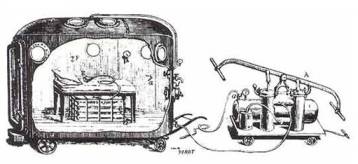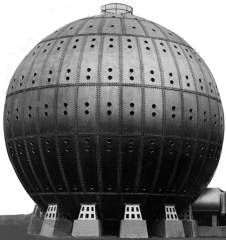Since the origins and development of hyperbaric therapy and diving medicine are closely tied, the use of compressed gas in medicine actually has ancient roots. We don’t know much about the origins of diving. But as far back as 4500 B.C. free-diving (breath-holding dives) for mother-of-pearl was a distinct occupation. In 320 B.C. Alexander the Great is said to have been lowered into the Bosphorus Straits in a glass barrel. Around 1500 A.D., Leonardo Da Vinci sketched various diving devices. However, none seem to have even been developed or used.
In 1620 Dutch inventor Cornelius Drebbel invented the first true diving bell. It had an open bottom and relied on the pressure of water to keep air trapped within the bell. The bell would be lowered into the water by crane and had ballast to keep the bell properly oriented. Air was pumped into the bell by a hose to keep fresh air within while excess gases would leak out from under the lip of the bell. As the bell sank deeper more air was pumped inside to keep the occupants comfortable. The bell was never meant to move under the control of the divers but served as an underwater base for free divers.
The first documented used of hyperbaric therapy actually came before the discovery of oxygen. In 1662, British clergyman named Henshaw, used a system of organ bellows to change the atmospheric pressure in a sealed chamber called a domicilium. This domicilium could create both hyperbaric and hypobaric environments. Despite lacking any scientific basis for his theories, Henshaw believed that acute conditions would benefit from increased air pressure, while chronic conditions would respond better to decreased air pressure. According to Henshaw, “In times of good health this domicilium is proposed as a good expedient to help digestion, to promote insensible respiration, to facilitate breathing and expectoration, and consequently, of excellent use for the prevention of most afflictions of the lungs.” Henshaw was only providing increased and decreased air pressure without increasing oxygen concentration. Oxygen was not discovered until 1773 by Swedish pharmacist Carl Wilhelm Scheele, and the term “oxygen” was not coined until 1777 by French chemist Antoine Lavoisier.
Nearly two centuries later, in the 1830’s, there was a rebirth of interest in hyperbaric medicine in France. In 1834, French physician Junod built a hyperbaric chamber to treat pulmonary afflictions using pressures of 2-4 ATA and reported increased circulation to the internal organs, improvements in cerebral blood flow, and production of feelings of well being. Then, in 1837, Pravaz built the largest hyperbaric chamber of that time and was used to treat patients with pulmonary conditions including tuberculosis, laryngitis, tracheitis and pertussis, as well unrelated conditoins such as cholera, conjunctivitis, deafness, menorrhagia and rickets.
In 1860, the first hyperbaric chamber on the North American continent was constructed in Oshawa, Ontario, Canada. A year later, Corning built the first hyperbaric chamber in the United States in New York. This chamber was used to treat ‘nervous and related disorders’.

In 1877, French surgeon Fontaine developed the first mobile hyperbaric operating theatre or operating room that took advantage of a basic law of physics; Henry’s Law. Henry’s Law states that the solubility of gas in a liquid is proportional to the pressure of the gas over the solution. This chamber was recommended to facilitate the reduction of hernia, and for patients with asthma, chronic bronchitis, emphysema and anemia. Within a 3 month period, twenty-seven operations were preformed in this mobile hyperbaric chamber. Due to great success a large hyperbaric surgical amphitheatre was planned and would hold 300 people. The plans never actually came into being. Fontaine would later die from an accident at the Pneumatic Institute and be considered the first physician martyr to Hyperbaric Medicine.
In 1885, C. Theodore Williams commented in an article “Lectures on the Compressed Air Bath and its Uses in the Treatment of Disease” the British Medical Journal, “The use of atmospheric air under different degrees of atmospheric pressure, in the treatment of disease, is one of the most important advances in modern medicine and when we consider the simplicity of the agent, the exact methods by which it may be applied, and the precision with which it can be regulated to the requirements of each individual, we are astonished that in England this method of treatment has been so little used”.

Back in the United States in 1921, during the first closing days of the First World War, Orville J. Cunningham built a hyperbaric chamber in Lawrence, Kansas where he treated victims of the Spanish influenza epidemic that swept the USA. Cunningham theorized that atmospheric pressure or barometric factors were responsible for the higher mortality rates of those located at higher elevations. Cunningham reported remarkable improvements in patients who were cyanotic and comatose. Unfortunately, one night a mechanical failure caused a complete loss of pressurization and all of Dr. Cunningham’s patients died. Tragic and a sobering lesson, this did not deter Cunningham’s enthusiasm for hyperbaric air. He went on to treat diseases such as syphilis, hypertension, diabetes mellitus and cancer. He believed that anaerobic infections play a role in the etiology of all such diseases. In 1928, Cunningham built the largest hyperbaric chamber in the world in Cleveland, Ohio. This “Hyperbaric Hotel” was a five story high steel sphere at 64 feet in diameter. Each floor of this massive hyperbaric sphere had 12 bedrooms with all the amenities of a good hotel.
The growing awareness of Dr. Cunningham’s treatments prompted repeated request by the Bureau of Investigations of the American Medical Association (AMA) to validate his claims regarding the effectiveness of hyperbaric therapy. Some believe he simply didn’t want to share or cooperate with the AMA and others believed he was a total fraud. The chamber dismantled in 1937 and sold for scrap metal during World War II.
Drager was the first to explore the use of pressurized oxygen in decompression sickness. His protocols were put into practice by Behnke and Shaw in the late 1930s. In 1939, the US Navy began treating divers suffering decompression sickness with hyperbaric oxygen therapy. This was different than all of the previous uses of hyperbaric therapy which only used compressed air.
After World War II, the US military conducted research which brought greater knowledge about survivable pressures. As a result, throughout the late 1950s and early 1960s, the use of HBOT (or HBO) increased.

